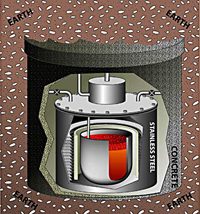
No moving parts
In its zeal to become more energy efficient and independent, the U.S. Air Force has announced it wants to build miniature nuclear power plants at bases worldwide. And in doing so, it might just be pointing the way to the future of off-grid energy everywhere.
This web site predicted rising interest in mini nuclear plants last December, citing the Westinghouse division of Toshiba as a possible player in the “personal nuclear reactor” market.
The current model of a very small number of very large nuclear reactors is flawed for several reasons, not least because it presents a tempting terrorist target, and the results of a human error could be catastrophic. But a very large number of very small nuclear reactors would reduce the risks of a big bang disaster – either by accident or design. The makers of the only mini nuclear plant in existence, Hyperion Power, say that although it would produce 27 megawatts worth of thermal energy, Hyperion doesn�t like to think of its product as a �reactor.� “It�s self-contained, involves no moving parts and, therefore, doesn�t require a human operator. ”
The U.S. Air Force is set to agree the location of at least one “small” nuclear-powered reactor by year end. “The plan is to be able to install these reactors on bases around the world to be able to run operations off the grid in case a terrorist attack cuts power, as well as to lower the Air Force’s carbon footprint,” reported the respected Federal Times in Washington DC.
According to another source, Kevin Billings, assistant secretary of the Air Force for energy, environment, safety and occupational health, said earlier this month at the Air Force’s second annual Energy Forum in Arlington, Virginia that the military would be a “predictable and welcoming host” for a reactor. He mentioned “small” several times in discussing the project but acknowledged that the Air Force was not prejudiced toward any particular size or design. Most bases would use a fraction of an LWR’s output.
The service will release a “request for proposals” next month to invite energy and defense firms to propose designs for small, on-base nuclear plants. The effort – backed by Republican Sens. Larry Craig of Idaho and Pete Domenici of New Mexico – is also intended to keep USAF bases off commercial power grids, which are more susceptible to blackouts and sabotage.
Representatives from Entergy and the Hyperion small reactor project were among those attending the nuclear session at the energy conference. the Hyperion Reactor is already being tested and the company expect to prodcue 4000 a year by 2012, according to the SF Reporter. One participant said he expected there might be a half-dozen “viable” proposals filed with the Air Force because such a project offered a way to alleviate political concerns with siting a nuclear power plant.
But the service might have trouble finding a willing partner. More than 60 CEOs attended the session, representing big-leaguers such as General Motors, Chevron, Boeing and Northrop Grumman, but also clean-energy companies like Rayan Solutions and Rentech. The refrain from many in the crowd was that the Air Force needs to pick out specific bases for the proposed reactors – and that only a multibase deal would offset heavy start-up costs. The Air Force has not tied the proposal to specific bases.
Discussions also focused on guarding, transporting and disposing of nuclear waste, and whether the service would be responsible for protecting the plant.
No matter what, the Air Force won’t own, operate or finance a mini-reactor, said USAF’s Billings. However, the service can work out land deals, sign long-term agreements to buy the power and allow energy providers to sell off excess nuclear power to outlying communities.
“I want to give the industry as much flexibility as possible” to secure a lucrative agreement that would serve a variety of bases, Billings said.
The southeastern U.S., he suggested, may be the most receptive to small nuclear reactors.
The Air Force urged the energy industry executives to be creative in coming up with proposals. The service seems “as willing to be accommodating as any government [entity] I’ve seen,” said John Longenecker, an energy consultant and former Energy Department deputy secretary of enrichment.
Billings reiterated that though the proposal could eventually prove to be a “nonstarter,” the Air Force is determined to at least try.
By October, the Air Force would like to have solid “letters of intent” from energy firms backed by reactor design proposals and nonbinding commitments.
Auto Amazon Links: No products found.

One Response
Bad, bad, bad. A “small” nuclear reactor is like being a “little bit” pregnant. Either way, you know you’ve been screwed.
Those who want to survive and perhaps even prevent a global climate change cataclysm are finding ways to live good lives with less. Those who don’t care about the planet or the human race are developing stupid ideas like this one because they think it will let them live the same wasteful, wasted lives they’re living now.
Problem is, they may just kill us all.